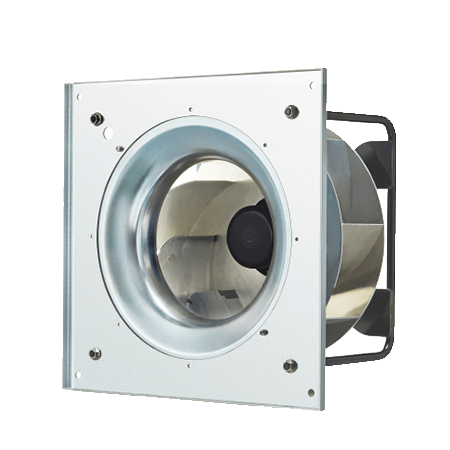All Rights Reserved Privacy Policy Site Map
FOCUS ON EC FAN ONLY
FOCUS ON EC FAN ONLY
Centrifugal fans are widely used across a variety of industries, from HVAC and air purification systems to refrigeration, automotive, and industrial machinery. Known for their ability to move air efficiently in high-pressure environments, these fans offer distinct advantages—but they also come with certain drawbacks depending on the application.
In this article, we’ll dive deep into the pros and cons of centrifugal fans, helping engineers, facility managers, OEM designers, and B2B buyers understand whether they are the right choice for your system. We'll also explore different types of centrifugal fans, common applications, and the difference between centrifugal and axial fans.
A centrifugal fan, also known as a blower, is a mechanical device that moves air or gas by increasing its pressure and displacing it radially through impellers. Unlike axial fans, which move air parallel to the shaft, centrifugal fans redirect airflow at a 90-degree angle.
Backward Curved Centrifugal Fans
Forward Curved Centrifugal Fans
Radial Blade Fans
Centrifugal Fans with Support Bracket
Single Inlet and Dual Inlet Blowers

Centrifugal fans are ideal for applications requiring high static pressure. Their impeller design allows them to push air through filters, ductwork, and resistance-heavy systems.
Use Case: Air filtration, fume extraction, HVAC systems.
These fans provide a stable, continuous airflow, even under variable system resistance. This makes them well-suited for systems where pressure drops or blockages may occur.
When integrated with Electronically Commutated (EC) motors, centrifugal fans become highly energy-efficient, offering up to 70% energy savings over traditional AC fan systems.
The sturdy construction and sealed motor design make centrifugal fans highly durable. They often operate with low maintenance over extended lifespans, especially models with brushless EC motors.
Centrifugal fans are available in a variety of form factors and sizes, including low-profile units and custom-molded housings, making them ideal for integration in confined spaces.
Unlike axial fans, which get louder when resistance increases, centrifugal fans operate more quietly under load, a valuable trait for noise-sensitive applications like medical equipment and HVAC in offices.
Centrifugal fans are used in:
Ventilation and Air Conditioning
Medical Devices
Cold Chain and Refrigeration
Electronics Cooling
Automobile HVAC Systems
Industrial Dust Collection
Centrifugal fans typically require more space for housing and ducting due to their radial airflow direction and impeller size.
Consideration: Not suitable for ultra-slim or portable equipment.
They require more precise design and installation, especially when ductwork must accommodate 90-degree airflow redirection. Incorrect ducting can reduce system efficiency.
The cost of centrifugal fans—especially EC centrifugal fans—tends to be higher than axial fans due to advanced components and housing.
ROI Note: Long-term energy savings often offset the upfront cost.
The robust construction and use of metal components can make these fans heavier, limiting use in mobile applications unless specifically designed for portability.
In dust-prone environments, forward-curved centrifugal fans may experience impeller clogging, requiring periodic cleaning or filtration pre-treatment.
| Feature | Centrifugal Fans | Axial Fans |
|---|---|---|
| Airflow Direction | Radial (90°) | Axial (Straight-through) |
| Static Pressure | High | Low |
| Energy Efficiency (with EC motor) | High | Moderate |
| Noise Under Resistance | Low | High |
| Size | Larger | More Compact |
| Applications | HVAC, industrial, medical | General ventilation, cooling towers |
Key Takeaway: Choose centrifugal fans for high-pressure systems and where reliability and energy savings are priorities. Axial fans are better for free-airflow applications and where space is limited.
When choosing a centrifugal fan for your project, consider the following factors:
Determine how much air volume the fan must move per minute. Higher CFM typically means a larger or faster fan.
Evaluate the resistance in your duct system or enclosure. Centrifugal fans are ideal for high-resistance systems.
Choose IP-rated fans like PBM Waterproof IP55 Fans for harsh or wet environments.
Use backward-curved impellers or EC fans for low-noise performance.
Measure your available installation space and select compact or low-profile options if needed.
EC fans can be easily integrated with PWM or analog speed control, making them suitable for automated systems and IoT-connected platforms.
PBM is a professional manufacturer of EC brushless motor and fan solutions with a global presence in over 50 countries. We provide:
Customized EC centrifugal fans
Global online support
Quick-response technical consultation
Wide product range: Forward/Backward Curved, Dual Inlet, Duct Fans, etc.
High-quality production with ISO and CE standards
Centrifugal fans are a reliable and efficient air-moving solution, especially for high-pressure applications in industrial, HVAC, medical, and commercial environments. While they have some limitations in terms of size and complexity, their benefits in performance, durability, and energy efficiency often outweigh these disadvantages—particularly when powered by advanced EC motors.
Whether you're an OEM looking for reliable components or a facility manager seeking energy-saving upgrades, understanding the pros and cons of centrifugal fans will help you make an informed, cost-effective choice.
By continuing to use the site you agree to our privacy policy Terms and Conditions.